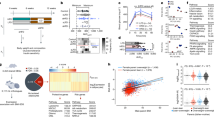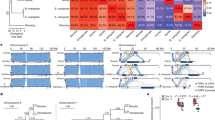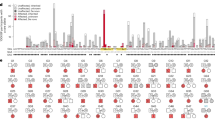Abstract
IT remains a mystery why autosomal trisomy is found more frequently than autosomal monosomy in man. Several surveys of spontaneous abortions have revealed these chromosomal abnormalities in proportions of 26% (ref. 1) and 0.1% (refs 1, 2), respectively, while a prospective study of 47,000 newborn babies revealed no full monosomy and only five cases in which parts of chromosomes were missing3. Similarly, in mouse embryos from translocation stocks bred to produce aneuploid progeny, high frequencies of trisomy but no monosomy are found after 12–13 days4,5. This is hard to understand because most autosomal aneuploidy is assumed to result from meiotic nondisjunction, so that for every gamete carrying two copies of a particular chromosome there should be a complementary gamete carrying none. However, the deficiency of monosomic embryos could be because nullisomic gametes are less able than disomic gametes to participate in fertilisation, or because the resulting monosomic embryos are less viable early in gestation. We report here the investigation of these possibilities in a mouse system which is known to produce a high frequency of nondisjunction. Equal numbers of monosomic and trisomie progeny were found early in gestation, but while some monosomies were compatible with survival to implantation, monosomy for the smallest mouse autosome, chromosome 19, was lethal at the early to mid-blastocyst stage. This lethality did not seem to be the result of the expression of recessive lethal genes.
This is a preview of subscription content, access via your institution
Access options
Subscribe to this journal
Receive 51 print issues and online access
$199.00 per year
only $3.90 per issue
Buy this article
- Purchase on Springer Link
- Instant access to full article PDF
Prices may be subject to local taxes which are calculated during checkout
Similar content being viewed by others
References
Hassold, T. J. et al. Ann. hum. Genet. 41, 443–454 (1978).
Boué, J., Boué, A. & Lazar, P. Aging Gametes, Proc. Int. Symp. 330–348 (Karger, Basel, 1975).
Nielsen, J. Humangenetik 26, 215–222 (1975).
Epstein, C. J., Tucker, G., Travis, B. & Gropp, A. Nature 267, 615–616 (1977).
Gropp, A., Kolbus, U. & Giers, D. Cytogenet. Cell Genet. 14, 42–62 (1975).
White, B. J., Tjio, J.-H., VandeWater, L. C. & Crandall, C. Cytogenet. Cell Genet. 13, 217–231 (1974).
Ford, C. E. The Early Development of Mammals (eds Balls, M. & Wild, A. E.) 285–304 (Cambridge University Press, 1975).
Golbus, M. S., Calarco, P. G. & Epstein, C. J. J. exp. Zool. 186, 207–216 (1973).
Golbus, M. S. & Epstein, C. J. Differentiation 2, 143–149 (1974).
Smith, L. J. J. exp. Zool. 132, 51–83 (1956).
Dyban, A. P. & Baranov, V. F. Cytogenetics of Mammalian Development (in Russian) (Nauk, Moscow, 1978).
White, B. J., Tjio, J.–H., VandeWater, L. C. & Crandall, C. Cytogenetics 11, 363–378 (1972).
Gropp, A., Giers, D. & Kolbus, U. Cytogenet. Cell Genet. 13, 511–535 (1974).
Hoehn, H. Am. J. hum. Genet. 27, 676–686 (1975).
Korenberg, J. R., Therman, E. & Denniston, C. Hum. Genet. 43, 13–22 (1978).
Sandler, L. & Hecht, F. Am. J. hum. Genet. 25, 332–339 (1973).
Epstein, C. J., Smith, S., Travis, B., Tucker, G. Nature 274, 500–503 (1978).
Nesbitt, M. N. & Francke, U. Chromosoma 41, 145–158 (1973).
Author information
Authors and Affiliations
Rights and permissions
About this article
Cite this article
EPSTEIN, C., TRAVIS, B. Preimplantation lethality of monosomy for mouse chromosome 19. Nature 280, 144–145 (1979). https://doi.org/10.1038/280144a0
Received:
Accepted:
Published:
Issue Date:
DOI: https://doi.org/10.1038/280144a0
This article is cited by
-
Targeting oocyte maturation to improve fertility in older women
Cell and Tissue Research (2016)
-
Impact of the number of Robertsonian chromosomes on germ cell death in wild male house mice
Chromosome Research (2015)
-
Mosaic variegated aneuploidy in mouse BubR1 deficient embryos and pregnancy loss in human
Chromosome Research (2014)
-
Complex cytogenetic analysis of early lethality mouse embryos
Chromosome Research (2011)
-
Cytogenetic analysis of sperm from a male heterozygous for a 13;14 Robertsonian translocation
Human Genetics (1988)
Comments
By submitting a comment you agree to abide by our Terms and Community Guidelines. If you find something abusive or that does not comply with our terms or guidelines please flag it as inappropriate.



